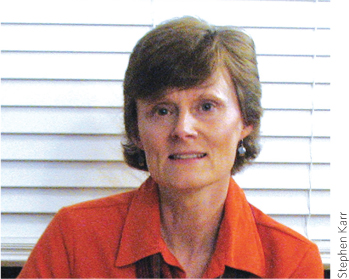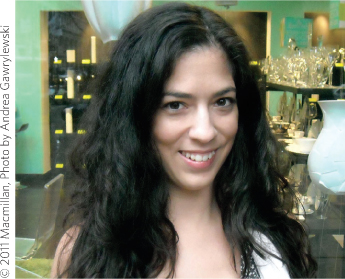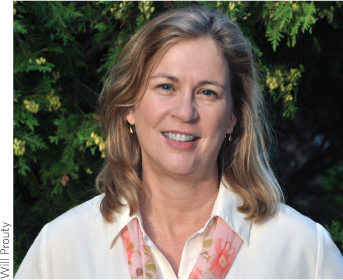ABOUT THE AUTHORS

SUSAN KARR, MS, is an Instructor in the biology department of Carson-Newman University in Jefferson City, Tennessee, and has been teaching for more than 20 years. She has served on campus and community environmental sustainability groups and helps produce an annual “State of the Environment” report on the environmental health of her county. In addition to teaching non-majors courses in environmental science and human biology, she teaches an upper-level course in animal behavior where she and her students train dogs from the local animal shelter in a program that improves the animals’ chances of adoption. She received degrees in animal behavior and forestry from the University of Georgia.

JENEEN INTERLANDI, MA, MS, is a science writer who contributes to Scientific American and The New York Times Magazine. Previously, she spent four years as a staff writer for Newsweek, where she covered health, science, and the environment. Jeneen has worked as a researcher at both Harvard Medical School and Lamont Doherty Earth Observatory. She was a 2013 Nieman Fellow. In 2014 she received a grant from the Pulitzer Center for Crisis Reporting, to cover the struggles of Roma ascension in Hungary. Jeneen holds Master’s degrees in environmental science and journalism, both from Columbia University in New York.

ANNE HOUTMAN, DPHIL, is Dean of the School of Natural Sciences, Mathematics and Engineering, and Professor of Biological Sciences at California State University, Bakersfield. Her research interests are in the behavioral ecology of birds. She is strongly committed to evidence-based, experiential education and has been an active participant in the national dialogue on science education—how best to teach science to future scientists and future science “consumers”—for almost 20 years. Anne received her doctorate in zoology from the University of Oxford and conducted postdoctoral research at the University of Toronto.
XIX
Dear Reader
Dear Reader,
For more than 20 years as an environmental science and biology instructor I’ve found that “stories” capture the imagination of my students. Students are genuinely interested in environmental issues—and using stories to teach these issues makes the science more relevant and meaningful to them. Many leave the class with an understanding that what they do really matters, and they feel a willingness to act on that knowledge. This is why I am enthusiastic about our textbook, Environmental Science for a Changing World.
Each chapter will keep students engaged and reading to find out “what happens next.” At the same time, explanations of science are woven into the narrative and illustrated in vivid infographics that give additional detail without slowing down the story. We’ve heard from instructors using the book (and our own students) and we know students are actually reading the textbook and being drawn into the stories, making it is easier for them to make connections between the environmental science concepts being taught and the “bigger picture” of why it matters.
In this book we’ve broken some topics down into multiple chapters—for instance, we present separate, short chapters on coal, petroleum and natural gas, and nuclear power rather than the traditional single chapter on conventional energy. This gives instructors the flexibility to focus on discrete topics if they choose.
In this second edition, we have added some popular chapters (originally in the extended edition only): Environmental Health, Environmental Policy, World Hunger, and Biodiversity Preservation. We also moved some of the chapters online to LaunchPad, the textbook’s web platform, as a way to make all of our chapters available to every adopter, giving even more flexibility in choosing which chapters and topics to cover. (LaunchPad chapters new to the second edition include a chapter on Mineral Resources and Geology as well as an additional agriculture chapter on Raising Livestock in CAFOs. Other chapters found in the first edition that now reside on LaunchPad include chapters on Forest Resources, Grasslands and Soils, Marine Resources, Fisheries, and Biofuels.) Every chapter has been updated to include the latest information.
We also listened to instructor feedback and in this second edition we have added pedagogical aids such as key concepts and end-of-chapter study aids that are tied to the guiding questions that open each chapter. This will help students focus on the important environmental science concepts being presented in the chapter. We’ve also added questions to each infographic to better engage the student with the figures and diagrams.
As with the first edition, the text focuses on building core competencies for the non-major: environmental literacy, science literacy, and information literacy. End-of-chapter and online exercises provide further opportunities to develop these competencies, as well as critical thinking skills.
Environmental Literacy: The scientific, social, political, and economic facets of contemporary environmental issues are examined with a focus on the scientific concepts and drivers underlying issues. Material is presented in a balanced way, especially for controversial topics. Sustainable solutions are presented.
Science Literacy: Each chapter includes experimental evidence and graphical data representation, and describes the day-to-day work of scientists, giving students many opportunities to evaluate evidence and understand the process of science.
Information Literacy: Students must be able to both find information and assess its quality. We explain how to effectively search for and find scientific information, and how to critically analyze that information.
Every person involved in this book—the writers, illustrators, editors, and fellow instructors—has one sincere objective: to help students become informed citizens who are able to analyze issues, evaluate arguments, discuss solutions, and recognize trade-offs as they make up their own minds about our most pressing environmental challenges.
Sincerely,

Susan Karr
XX